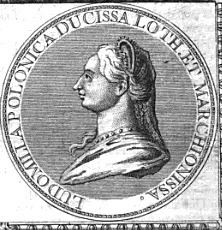Name Wierzchoslawa of Children Cunigunda of Lorraine | ||
 | ||
Parents Mieszko III the Old, Elizabeth of Hungary, Duchess of Greater Poland Grandparents Boleslaw III Wrymouth, Salomea of Berg, Bela II of Hungary, Helena of Serbia, Queen of Hungary Great-grandparents Wladyslaw I Herman, Almos Similar People Mieszko III the Old, Boleslaw III Wrymouth, Wladyslaw III Spindleshanks, Bela II of Hungary, Agnes of Germany | ||
Grandchildren Waleran of Monschau | ||
Wierzchoslawa Ludmilla of Greater Poland (Polish: Wierzchoslawa Ludmiła Mieszkówna; b. bef. 1153 – d. bef. 1223), was a Polish princess member of the House of Piast, by marriage Lady of Bitsch and during 1205-1206 Duchess of Lorraine.
She was the second daughter and fourth child of Mieszko III the Old, Duke of Greater Poland and since 1173 High Duke of Poland, by his first wife Elisabeth, daughter of King Béla II of Hungary. Her name was probably given after High Duchess Viacheslava of Novgorod, wife of Bolesław IV the Curly, the ruling High Duke of Poland; with this gesture, Duke Mieszko III maybe showed an expression of warming relations between him and his brother the High Duke.
Life
Around 1167, Wierzchoslawa Ludmilla married with Frederick, Lord of Bitsch, second son of Duke Matthias I of Lorraine. The union was arranged by Frederick's maternal uncle Frederick I, Holy Roman Emperor during a visit to Poland. During her marriage, Wierzchoslawa Ludmilla bore her husband nine children:
Wierzchosława Ludmilla became the contact between the French and Polish artistic representatives. One of the theories about the building of the famous Gniezno Doors states that thanks to her efforts, around 1180 the Doors came to her father's court.
After years of disputes between Frederick and his brother Duke Simon II of Lorraine, in 1205 he finally abdicated and entered a monastery. Then Frederick became the Duke of Lorraine and Wierzchosława Ludmilla his duchess consort. However, their reign was short-lived: one year later, in 1206, Duke Frederick I died. Wierzchosława Ludmilla returned to Poland after the death of her husband, and remained there until her own death, around 1223.
